May 2010
American VI: Ain’t No Grave
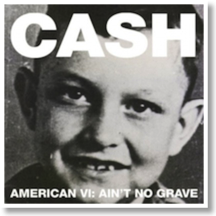
American VI: Ain’t No Grave
American and Lost Highway
Rivaling Hank Williams as the greatest country music artist of all time, Johnny Cash’s legacy is nothing short of towering and exhilarating. His alteration of the rock and popular musical landscape cannot be overstated, and his large musical portfolio consists of sounds as varied as his typical country music (“I Walk The Line”), rock (“Hurt”), blues-folk (“Folsom Prison Blues”), and especially his slew of gospel music classics (among them Hymns of Johnny Cash, The Gospel Road soundtrack and “He Turned The Water Into Wine”).
American VI: Ain’t No Grave (2010), the latest installment in Johnny Cash’s well-received American Recordings series that began in the early ‘90s under the aegis of legendary producer Rick Rubin, expands on his rich and classic recorded output. As demonstrated on previous folk-rooted records, Cash sides traditional tunes with modern compositions, and spiritual themes dress the album and connect to life’s downfalls and positivity.
The set is initiated by the timeless spiritual “Ain’t No Grave”, written by Pentecostal preacher Brother Claude Ely (“There’s a Leak in This Old Building,” “Holy, Holy, Holy”). In a somberly fashion, Cash moves along to the beat of clanking shackles, stomping feet and a lone banjo, evoking imprisonment trials and woes. But this moody, spiritual-blues interpretation differs from the bright, romantically-laced “Aloha Oe” (“Farewell to Thee”), penned by Queen Lili’uokalani of Hawaii in 1876. It may seem a little odd in the record’s collection of songs, but in a way it serves as a tribute to the contribution of the Hawaiian steel guitar to country music’s early building blocks.
When Cash performed a rendition of the famed Trent Reznor’s evergreen “Hurt” (originally found on the 1994 Nine Inch Nails gem The Downward Spiral), he saw an nstant classic born, a record that was revered as among his best and as among the greatest of the 21st century. On Ain’t No Grave, Cash replaces “Hurt” with the optimistic “I Don’t Hurt Anymore” and takes on the respected rocker Sheryl Crow’s “Redemption Day” to make it his own. While not as grand as his take on “Hurt”, Cash still performs exceptionally, injecting his melancholic-inspired vocal belied by a sparsely doomed background. But once again, it is balanced by his friend Kris Kristofferson’s sweet ballad “For the Good Times”.
In essence, American VI: Ain’t No Grave seemingly reaches equilibrium with hopes and joys. For every “Where I’m Bound” (composed by folk master Tom Paxton), the hopeless “Cool Water” (the standard inked by Bob Nolan) and the obviously Biblical “I Corinthians 15:55” (translated as “Where, O death, is your victory? Where, O death, is your sting”), there is the content “Satisfied Mind” and the peaceful classic penned by Ed McCurdy, “Last Night I Had the Strangest Dream”. Again, Cash effectively combines disparate American folk roots to create a distinctive musical language that he can call his own, documenting American music at its most basic.
Johnny Cash said it best about his musical career: Ain’t No Grave can keep his immense and immeasurably influential body of work down into the dreaded part of historical obscurity.
by Jeff Boyce
Radiant Sky
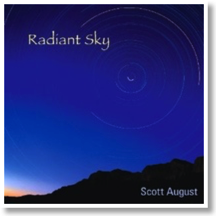
Radiant Sky
Cedar Mesa Music
The American definition of “folk music” is a broad one. One camp might classify it as traditional music from foreign origins (usually from English-speaking Europe), while another might include blues, gospel and other early musical texts. But in essence, folk music is music passed down orally; usually performed and listened to by the lower classes, it can have indefinite origins in terms of composer and region. In general, American musicologists have called this loose label of native music “roots music,” which is an appropriate term that paved the way for the mass-marketed popular music of jazz and rock-n-roll. By the same token, folk music has evolved throughout the years to reflect the change in times and has seen its fair share of commercial success.
The first folk music of the Americas is from the indigenous peoples and was generally sacred and ceremonial music. Celebrating spirituality, power and nature are common elements of this musical idiom, and centuries later, Native American music can still be heard live and on record. Using the CD format, Native American music multi-instrumentalist Scott August’s Radiant Sky beautifully paints an epic tribute to these people and their music in the more modern context of New Age music. New Age music developed primarily in the 1970s and is a largely instrumental musical genre informed by electronic and acoustic sound devices and a holistic and spiritual approach to life. Its peak in the late 1980s and early 1990s opened up the market to an international audience, leading the way for artists and musicians such as August.
Since 1996, Scott August has championed Native American flute music to great praise, founding his Cedar Mesa Music label. He has garnered wide respect at major Native American musical festivals, media appearances from NASA to The Discovery Channel and great sales in the New Age/native folk musical arena. Radiant Sky enhances August’s lulling and meditative excursions of musical craft. Layered and engrossing, each track vividly captures what the title entails in a thematic tale of a single day’s entrance and exit, linking a nostalgic timeframe with a newfound optimism that tells the story of history’s omnipotent power.
“Calling the Sun,” which opens the album, exudes the feeling of a morning sun slowly awakening and enveloping the land below it, like a storyteller preparing to cite a message of wisdom and power. “New Horizons” is more pronounced, signaling the vibrancy of a new day, and “Arc of Dreams” lets the mind wander in its wake. “Santa Fe” is jubilant, like a storyteller revealing a climactic scene, before Radiant Sky drifts away with the soothing “A Pale Radiance” and “Searching Beyond,” which give the impression that the way to the future lies in the present and the past and that the mind’s own journey is limitless. As demonstrated on previous works, Radiant Sky features the solo flute (“Since the Stars Fell), guitar (“Journey of Solace”) and the difficult-to-play Anasazi flute, which August has mastered. Ambient sounds also permeate the album, giving a nod to its prized practitioners Steve Roach and the “Father of Ambient Music,” Brian Eno.
In an atmospheric swirl of originality, talent and serenity, Scott August’s brand of Native American flute-based music in Radiant Sky pieces ancient sounds with nontraditional methods and effortlessly connects a story of history in the context of a day. A day is like a thousand years when you look to the heavens; the time-lapse photography of the North Star on the CD cover is proof of this.
by Jeff Boyce
Love Comes Home
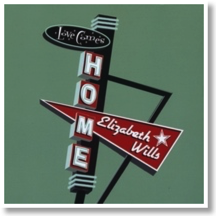
Love Comes Home
Bugle Boy Foundation Trust
Elizabeth Wills is a giver. The Texan singer-songwriter is not embarrassed of her naked confessionals or afraid to admit feelings. Her recent album, Love Comes Home, is a document of the lovelorn, folk-pop artist’s search for love. However, the unnamed object of Wills’ desire cannot handle her love.
The opening trio of songs paints a quixotic woman swept up in infatuation. In the jaunty “One By One,” Wills opens the album traversing the open road with an open heart. Struck with wanderlust, she travels for miles with the thought of her beloved still implanted in her mind. Since her distance is no obstacle, she declares, “One by one, here I come” when she decides to return home. With the help of a million angels – “Million Angels,” a slow-burner of a song – Wills makes a bright-eyed admission: “I got this love, sweet love, and it’s living in me.”
Along with “Favorite Things,” the opening triptych of pop alt-country tunes evokes the airy, direct style of Carole King, and this is no accident. The album was produced and engineered by Austinite Mark Hallman, who has worked with singer-songwriters such as Ani DiFranco, Eliza Gilkyson and, of course, King. But the production never overwhelms Wills’ singing. Despite a delicate voice, her words are front and center, emanating strong confidence over the tenacious, moving drums and insistent guitars.
But then, the album’s midsection deals with the painful realization that the love is unrequited or lost. It begins with the spare “In the Broken,” a soul-baring plea to understand the severed ties with her lover – “There’s peace in the broken…But if your heart is open, it’s not empty at all.” It is a simple song that eerily finds Wills practically alone. A Kerrville Folk Festival New Folk Competition finalist, she shines here.
Wills begins to think that love’s an impossibility by the time the introspective “Blackbird Song” comes along. She may use arbitrary numbers to emote, but with Wills’ heartbreaking honesty – “I’ve given this lovin’ the best that I can. 2,000 times now, I’ve held out my hand” – you believe her. Even the constant, comforting presence of celestial bodies she refers to throughout the album – the sky, sun, moon and stars – are not as certain as before: “I’m beginning to think I won’t see the sunrise.”
With the calm, collected folk of the denouement, “Timing,” Wills rationalizes that love cannot compete with time. Thankful for what she’s been given, she’s confident her chance at love will come again.
by Joshua Barajas
Mr. Sad Clown
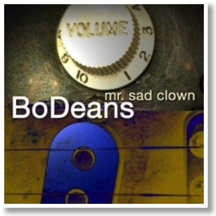
Mr. Sad Clown
429 Records
The Bodeans’ rootsy alternative rock landed them mid-level chart successes, capping with the Top 40 classic “Closer to Free,” closely associated with the popular TV series Party of Five, and they were praised by U2 and Robbie Robertson, formerly of the seminal rock outfit The Band. After a more than two-decade critically approved career, singer, songwriters and guitarists Kurt Neumann and Sammy Llanas, the core members, have crafted another fine release, Mr. Sad Clown, which is dressed in a central theme of wistful beauty and sadness.
An homage to Austin, Texas, is paid in the lively and hooky “Shine” (“Written in Austin…It was a gorgeous night,” Llanas says), and the heartfelt “If” speaks of feeling abandoned even in a temporary setting (“In this oyster of a world I was lucky to have found my pearl…now I’m standing at the station…I know it’s just vacation but my heart is breaking anyway”). “Don’t Fall Down” has a fun country edge to it and “Cheesecake Pan” is an odd metaphor for a heart seeking carnal affection.
“Today” is the pick of the album. Neumann and Llanas harmonize that being sincere doesn’t always conform to social acceptance (“Everybody knows everybody else but me…I know you feel I’m crazy…Mister sad clown you’re lingering in a bad place”). Rivaling “Today” is “Headed for the End of the World,” commenting on power, greed and corruption and the role of the common man as a pawn in all of this (“The great equalizer is evolution,” Llanas mentions, “So take your allotted little piece of nothingness and live it up”). The song ends with a matter-of-fact “Maybe begin, again…but it ends up the same each time.”
Mr. Sad Clown hits reflective terrain near its end in “Almost Ready,” “Back Then” and “Gone X 3.” “I think the reason we’ve stayed popular with the fans all these years is that we’re real guys, not trying to be anything special…and getting into goth or another cool flavor of the moment,” Llanas remarks. So maturity is the key, and the BoDeans have managed to essentially move forward with newfound experiences while managing to stay close to their brand of music on Mr. Sad Clown. Llanas elaborates: “Let’s face it, we’re not kids anymore.”
by Jeff Boyce
Away We Go
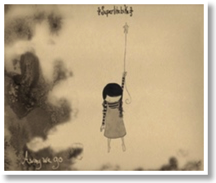
Away We Go
Self-release
The SuperLiteBike collective could all be ad men. Prior to their shows, they produced over-the-top video flyers with band members running from green screen explosions, reenacting television standards such as news programs and game shows, while referencing everything from “Lost” to the Keyboard Cat. Those media-savvy promotions reveal a band very much attuned to the information-saturated environment around them. Or, they’re just a bunch of guys that like hanging out. Either way, their debut release balances earnestness -- the “We can all live together” line from “Something With Spectrum” -- and pure entertainment.
Originally called A Pocketful of Deng, the band changed its name after a small line-up change with the addition of Chris Heckendorn of The War Against Sleep and All My Friends, an LCD Soundsystem tribute band. Away We Go is their redefinition as a band and a document of the plaintive realities of adult life. Opener “That’s A Lot Of Adhesive” volleys much like the ups and downs expected in life as drums crescendo every two bars in a Sisyphean attempt to trudge forward. Once the tempo quickens and the guitar turns plucky, Patrick Husband reminds us that “good times are coming.” Even when the huge boulder rolls back down the hill, he repeats the mantra as if he needed to hear it himself as the plodding drums return.
For an album concerned with the intricacies of life, it never looks back to romanticize what was lost or once was. Much is made about transition, which is inherently found in the transportability of the band’s namesake. “The Great Erie,” itself a one-minute transition, melds into the aforementioned “Spectrum,” a driving song that doubles as a pep talk: “You fall right down, gotta get up, this is your town. You worked too long just to get shot down.” Yet, much like Thom Yorke, Husband sounds unsettling when delivering these lines. Along with the chorus of trumpets, the song is empathetic, and reminds us that we’re not alone in our anxieties.
If life is a struggle to strive for happiness, then happiness comes in the form of the track, “Unbelievable Party!!! Cool.” Its objective is clear: dance. A bare-boned track of stripped-down elements, its bass-driven funk is all about letting go, getting low: “Open your mind for free…” As the album’s longest track, “Let’s See A Jet Plane” reaches skyward as instrumentation unfurls. Once it reaches it dissonant freak-out at the end, it closes the album with its grounded epiphany of allowing oneself to dream, but not to sleep.
by Joshua Barajas
Sunshine and Other Misfortunes
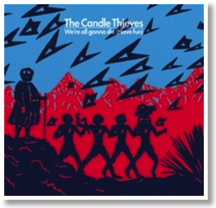
Sunshine and Other Misfortunes
Mercer Street Records/Downtown Records
“We’re All Gonna Die,” which floats on the rather-clichéd “have some fun while you can” manifesto, is a cheerful ‘60s throwback production that mixes the Beach Boys with Stax-tinged horns while retaining a modern edge through a funk and hip hop sample (“everybody clap your hands”) and quirky effects that recall the early punk and New Wave eras.
This first track from The Candle Thieves’ (Scott McEwan and “The Glock”) latest album Sunshine and Other Misfortunes prepares the listener for the English band’s offering of what could be dubbed “neo-sunshine pop.” It should be noted that the duo has a penchant for toy pianos, Casio keyboards and glockenspiels. Moreover, Scott’s vocals sound “twee pop” or recall the lighter fare of ‘60s rock-pop ala Gerry & the Pacemakers. “Catching Wasps,” “Sharks and Bears,” “Stars” and “The Sunshine Song” are just some of the titles that frame the album and would make fine titles for nursery-styled rhymes.
However, the album is not steeped in adolescent imagery despite the simple titles. For example, “The Sunshine Song” has a negative tinge to it, and the melancholic “Bright Lights” has a sort of sinister aura. “Sharks and Bears” claims that ease in life is hard to come by, and the universal “Not the Only One” paints the image of being in an ER room. “Dreaming of Lucy” is beautifully laconic, and “Singapore” isn’t a title one would likely find on a record like this. The sprightly “My Little Room” is awash in Jan & Dean and Beach Boys influences with upbeat handclaps, surf-inflected guitar and Beach Boys-inspired harmonies (the Beach Boys had a classic ballad called “In My Room”). The sleigh bell sound on the track recalls another Beach Boys golden oldie, “Dance, Dance, Dance.”
The Candle Thieves’ Sunshine and Other Misfortunes no doubt takes its cues from the gentler and whimsical ‘60s musical styles, especially the often surreal and adolescent sunshine pop perfected in California. But the duo throw in their own quirkiness into the cauldron and enrich it with a modern flair that doesn’t make it merely nostalgic. It has the potential to appeal to all music listeners, which is a hard goal to aspire to in today’s musical scene.
by Jeff Boyce


